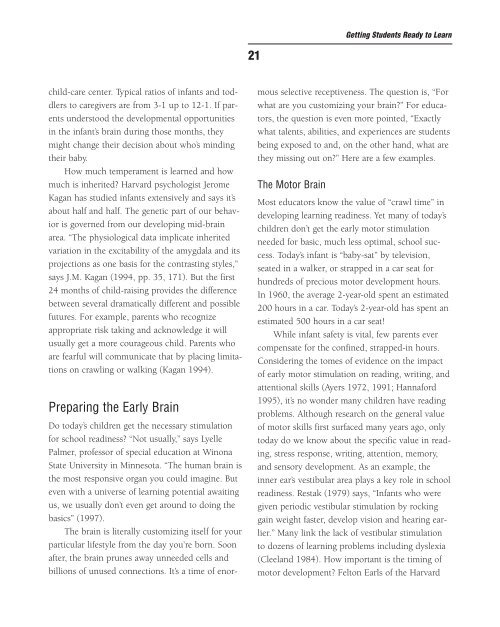Create successful ePaper yourself
Turn your PDF publications into a flip-book with our unique Google optimized e-Paper software.
child-care center. Typical ratios of <strong>in</strong>fants and toddlers<br />
to caregivers are from 3-1 up to 12-1. If parents<br />
understood <strong>the</strong> developmental opportunities<br />
<strong>in</strong> <strong>the</strong> <strong>in</strong>fant’s bra<strong>in</strong> dur<strong>in</strong>g those months, <strong>the</strong>y<br />
might change <strong>the</strong>ir decision about who’s m<strong>in</strong>d<strong>in</strong>g<br />
<strong>the</strong>ir baby.<br />
How much temperament is learned and how<br />
much is <strong>in</strong>herited? Harvard psychologist Jerome<br />
Kagan has studied <strong>in</strong>fants extensively and says it’s<br />
about half and half. The genetic part of our behavior<br />
is governed from our develop<strong>in</strong>g mid-bra<strong>in</strong><br />
area. “The physiological data implicate <strong>in</strong>herited<br />
variation <strong>in</strong> <strong>the</strong> excitability of <strong>the</strong> amygdala and its<br />
projections as one basis for <strong>the</strong> contrast<strong>in</strong>g styles,”<br />
says J.M. Kagan (1994, pp. 35, 171). But <strong>the</strong> first<br />
24 months of child-rais<strong>in</strong>g provides <strong>the</strong> difference<br />
between several dramatically different and possible<br />
futures. For example, parents who recognize<br />
appropriate risk tak<strong>in</strong>g and acknowledge it will<br />
usually get a more courageous child. Parents who<br />
are fearful will communicate that by plac<strong>in</strong>g limitations<br />
on crawl<strong>in</strong>g or walk<strong>in</strong>g (Kagan 1994).<br />
Prepar<strong>in</strong>g <strong>the</strong> Early <strong>Bra<strong>in</strong></strong><br />
Do today’s children get <strong>the</strong> necessary stimulation<br />
for school read<strong>in</strong>ess? “Not usually,” says Lyelle<br />
Palmer, professor of special education at W<strong>in</strong>ona<br />
State University <strong>in</strong> M<strong>in</strong>nesota. “The human bra<strong>in</strong> is<br />
<strong>the</strong> most responsive organ you could imag<strong>in</strong>e. But<br />
even with a universe of learn<strong>in</strong>g potential await<strong>in</strong>g<br />
us, we usually don’t even get around to do<strong>in</strong>g <strong>the</strong><br />
basics” (1997).<br />
The bra<strong>in</strong> is literally customiz<strong>in</strong>g itself for your<br />
particular lifestyle from <strong>the</strong> day you’re born. Soon<br />
after, <strong>the</strong> bra<strong>in</strong> prunes away unneeded cells and<br />
billions of unused connections. It’s a time of enor-<br />
21<br />
mous selective receptiveness. The question is, “For<br />
what are you customiz<strong>in</strong>g your bra<strong>in</strong>?” For educators,<br />
<strong>the</strong> question is even more po<strong>in</strong>ted, “Exactly<br />
what talents, abilities, and experiences are students<br />
be<strong>in</strong>g exposed to and, on <strong>the</strong> o<strong>the</strong>r hand, what are<br />
<strong>the</strong>y miss<strong>in</strong>g out on?” Here are a few examples.<br />
The Motor <strong>Bra<strong>in</strong></strong><br />
Gett<strong>in</strong>g Students Ready to Learn<br />
Most educators know <strong>the</strong> value of “crawl time” <strong>in</strong><br />
develop<strong>in</strong>g learn<strong>in</strong>g read<strong>in</strong>ess. Yet many of today’s<br />
children don’t get <strong>the</strong> early motor stimulation<br />
needed for basic, much less optimal, school success.<br />
Today’s <strong>in</strong>fant is “baby-sat” by television,<br />
seated <strong>in</strong> a walker, or strapped <strong>in</strong> a car seat for<br />
hundreds of precious motor development hours.<br />
In 1960, <strong>the</strong> average 2-year-old spent an estimated<br />
200 hours <strong>in</strong> a car. Today’s 2-year-old has spent an<br />
estimated 500 hours <strong>in</strong> a car seat!<br />
While <strong>in</strong>fant safety is vital, few parents ever<br />
compensate for <strong>the</strong> conf<strong>in</strong>ed, strapped-<strong>in</strong> hours.<br />
Consider<strong>in</strong>g <strong>the</strong> tomes of evidence on <strong>the</strong> impact<br />
of early motor stimulation on read<strong>in</strong>g, writ<strong>in</strong>g, and<br />
attentional skills (Ayers 1972, 1991; Hannaford<br />
1995), it’s no wonder many children have read<strong>in</strong>g<br />
problems. Although research on <strong>the</strong> general value<br />
of motor skills first surfaced many years ago, only<br />
today do we know about <strong>the</strong> specific value <strong>in</strong> read<strong>in</strong>g,<br />
stress response, writ<strong>in</strong>g, attention, memory,<br />
and sensory development. As an example, <strong>the</strong><br />
<strong>in</strong>ner ear’s vestibular area plays a key role <strong>in</strong> school<br />
read<strong>in</strong>ess. Restak (1979) says, “Infants who were<br />
given periodic vestibular stimulation by rock<strong>in</strong>g<br />
ga<strong>in</strong> weight faster, develop vision and hear<strong>in</strong>g earlier.”<br />
Many l<strong>in</strong>k <strong>the</strong> lack of vestibular stimulation<br />
to dozens of learn<strong>in</strong>g problems <strong>in</strong>clud<strong>in</strong>g dyslexia<br />
(Cleeland 1984). How important is <strong>the</strong> tim<strong>in</strong>g of<br />
motor development? Felton Earls of <strong>the</strong> Harvard



